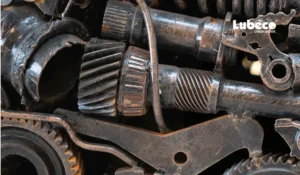Water soluble metal cutting fluids, also known as metalworking fluids or cutting fluids, are substances used in machining to lubricate, cool, and remove chips from a workpiece. These fluids are formulated to mix with water for effective performance in metalworking applications. A cutting fluid is basically a type of fluid commonly used in the cutting process. Mainly used for machining operations including drilling, milling, turning, cutting, etc.
They are used to improve cutting conditions and improve tool life. It is also known as a coolant or lubricant because it reduces the heat generated during metalworking, i.e., it cools the cutting tool.
Types of Water Soluble Cutting Fluids:
Every type of cutting fluid has advantages and things to keep in mind. The choice of a particular kind is influenced by elements such the machining operation, the material being machined, the cutting circumstances, and environmental issues. To choose the best fluid for a given application, it is advised to speak with cutting fluid suppliers or manufacturers. Soluble cutting oils, semi-synthetic cutting oils, and synthetic cutting fluids (grinding fluids) are the three main categories into which water soluble cutting fluids are typically divided.
Soluble Cutting Fluids
Cutting fluids that are soluble in water are made up of coarse insoluble phase combinations. A base oil, emulsifiers, anti-wear, severe pressure, anti-foaming additives, corrosion inhibitors, bactericides, etc. are all combined to create an emulsion. As mineral bases, medium viscosity petroleum-based or mixed-type mineral oils are typically utilized; up to 85% of the emulsion can contain these oils.
Semi- synthetic Cutting Fluid
Semi-synthetic coolants are concentrations of metalworking fluids that also include synthetic lubricants, additives, and a tiny amount of oil. Semi-synthetics combine the chemical lubricity, cooling, and washability of synthetic coolants with the physical lubricity of soluble oils to produce a translucent fluid when combined with water. They always comprise low-viscosity (3-10 mm2/s at 50°C) mineral or synthetic oils, as well as extreme pressure, anti-wear additives, etc. They also contain a higher percentage of emulsifiers (up to 40%).
Synthetic Cutting Fluid
Organic compounds that are water soluble and have been dispersed into molecules make up synthetic cutting fluids. They don’t contain petroleum or mineral oil, which when combined with water produces a clear, colorless fluid. Instead, they are made from organic alkaline materials.
Applications of Water- Soluble Cutting Fluids:
Numerous industries and machining techniques make substantial use of water-soluble metal cutting fluids. These fluids are used in the automotive industry to machine parts for the engines, transmissions, and chassis. They are used in the machining of structural elements, turbine parts, and aircraft parts in the aerospace industry. Additionally, water-soluble metal cutting fluids are used in a variety of machining activities in the oil and gas, medical device, electronics, and general manufacturing sectors.
Utilizing these fluids has advantages beyond lubricating and cooling. They support chip evacuation, avoiding chip accumulation that can impair cutting performance. They help the machined items’ surface finish and dimensional accuracy by keeping the cutting zone clean. Additionally, the fluids serve as a barrier to avoid direct contact between the cutting tool and the workpiece, which lessens wear and increases tool life. In comparison to oil-based fluids, water-soluble metal cutting fluids provide advantages for the environment. They are frequently designed to be biofriendly and offer enhanced biodegradability, decreased toxicity, and reduced environmental effect.
Hence, water-soluble metal cutting fluids are vital in the machining sector due to their adaptability and efficiency. They are used in many different industries and processes, which helps to increase production, prolong tool life, provide better surfaces, and save the environment. As a result of ongoing improvements in fluid formulas and technology, machining operations are reliable and efficient.
Benefits of Water-Soluble Metal Cutting Fluids
- Lubrication and Cooling:
Cutting fluids offer lubrication between the cutting tool and the workpiece, lowering friction and wear. They also provide cooling. By extending the life of cutting equipment, this boosts production and reduces costs. Cutting fluids disperse heat produced by the cutting process during machining. They aid in preserving constant cutting zone temperatures, avoiding the buildup of excessive heat that could result in thermal damage, workpiece distortion, or tool failure. Additionally, efficient cooling enhances surface polish and machining precision.
- Prevents corrosion and rust
Cutting fluids prevent corrosion in metals such as stainless steel, carbon steel, cast iron, and wrought iron. Corrosion thrives in conditions with extreme heat, moisture, and oxygen. Cutting fluids with a pH level higher than nine, on the other hand, can assist in stopping corrosion in ferrous metals. Brass, bronze, and other non-ferrous metals will require a different pH than aluminum.The cooling effect of the proper cutting fluid dissipates heat and inhibits corrosion. To ensure that the machining process is well-oiled, the soluble cutting oil serves as grease. Additionally, the cutting fluid stops bacteria from growing inside the machine, particularly in the built-up cutting oil. These microorganisms taint the cutting fluid and make it unsafe to use.
- Economical expenses
Compared to straight oils, costs are reduced because water dilution has a positive effect. However, this can occasionally be misleading because employing water-soluble fluids necessitates maintenance steps that are not necessary with cutting oils. Regular concentration, pH, and bacterial level monitoring are all part of maintenance processes.
- Chip Evacuation
Cutting fluids help with the effective evacuation of chips or swarf from the cutting zone. They aid in chip flushing, reducing the chance of workpiece damage and chip recutting.To prevent equipment failures, this debris must be flushed out, and chip removal should keep pace with chip development. Metal shavings and tramp oil in excess are undesirable. They build up inside the apparatus and taint the cutting fluid. It is necessary to remove and clean the machine’s old cutting fluid. Effective chip evacuation increases machining performance and lowers the risk of tool failure.
- Tool life Extension
Extending the life of a tool is made possible by the lubricating and cooling effects of cutting fluids. Cutting fluids improve tool performance, lessen the need for frequent tool changes, and cut down on overall machining costs by limiting tool degradation.They minimize tool degradation and prolong sharpness by reducing friction and wear on tool cutting edges.It also diffuses heat produced during machining, protecting the tool from thermal damage that aids to sustainable tool performance, lessen the need for frequent tool changes, and lower total machining costs by minimizing wear and managing heat.
How Can Water-Soluble Cutting Fluids Be Used During the Machining Process?
- Ensure that the water-soluble substances go in the container last and are mixed with water last.
- After mixing, it is crucial to measure the concentration. You can do this by utilizing a pH meter or refractometer.
- Foaming and oil-separation issues will result from mixing with hard water. Prior to making the emulsion, it is advised that hard water be treated.









